Of Mountains and Technology: To Disrupt or Empower?
Date
Long before any digital revolution, John Muir thought of mountains as “temples,” writing in his book Our National Parks, “Thousands of tired, nerve-shaken, over-civilized people are beginning to find out that going to the mountains is going home; that wildness is a necessity.”
In a time of 4G networks, a constant “news” cycle, notifications, and never-ending messaging, Muir’s words seem even more prescient. My family has always made it a priority to escape to the mountains every summer and this escape, even though is seems harder than ever to schedule, has never been more precious.
With smartphones disconnected, conversations on the trail meander through a wide range of topics, and we discuss questions instead of answering them with a quick Google search. Long lulls in conversations provide unrushed time for thinking. Or, we just enjoy being with each other in a beautiful spot. In the blur of each year, my time with family and friends in the mountains always stand out as some of the most memorable moments.
One such memory from this last year is a hike in the northern Sierra Nevada with my father, a retired high school history teacher. In my mind, my dad was a model of an effective teacher, a big part of the reason that I was drawn to education. I’m not sure my dad ever gave a scantron assessment; I like to think that his classes required students to think, not regurgitate facts. On this hike, we were discussing my job, layering a technology lens over education. I wouldn’t say that my dad is a technology skeptic, but he is wary about the value that technology adds to the classroom.
Lately I’ve been spending a lot of time with Google, exploring best practices for integrating G Suite apps into the classroom. I told my dad how teachers are using Google Forms as exit tickets to figure out what students understand and what they still have questions about. My dad used a variation on exit tickets, asking his students to write weekly journal entries. In an attempt to give each student what they needed, he would lug piles of journals home and spend his night-time hours responding to students. A tool like Forms could not only streamline his process, but also possibly improve it. Item types like the Linear Scale could help him better quantify trends in student sentiments, and File Uploads would allow students to attach evidence to support their responses.
As we continued down the trail, the conversation drifted through emerging technologies. I could tell that my dad’s brain was spinning with ideas for improving the experience of his students, even though he has been retired for more than ten years.
These days, you hear a lot about “disruption,” “innovation”, and “experimentation” when it comes to reimagining educational approaches. Personally, I don’t believe that transformation requires throwing everything out and starting from scratch. Effective pedagogy always takes precedence over technology, and teachers still know best. Yes, the best teachers are those that continue to grow and the role of the technology in the education and lives of our students in the digital age cannot be ignored. However, according to the TPACK model, a teacher’s technology knowledge also includes “being able to recognize when information technology can assist or impede the achievement of a goal.
At a technology training in Niagara Falls last month, I worked with a room full of middle school ELA teachers. Even though the educators were experienced, enthusiastic, and committed to their practice, many of the technology tools we explored were entirely new to participants. So many available options can make getting started feel overwhelming. I encouraged participants to start with one new tool: play with it and try it in the classroom. Gradual adoption of digital toolbox gives teachers (and students) an opportunity to acclimate to a digital learning environment. But these teachers, just my like my father, should be the judges of when, how, and if the new tools should be used in the classroom.
In the mountains, I admit there are times that I’d love an internet connection. I can itch to read the news, check in with work, or even just see if rain is in the forecast, but the mountains are more stunning in technology’s absence. Unlike in the mountains, technology plays a positive role in 21st century classrooms. I just hope that teachers are given the space and the power to make informed decisions about how it is integrated. For true transformation, the use of technology in our schools should be purposeful and based on sound pedagogy.

